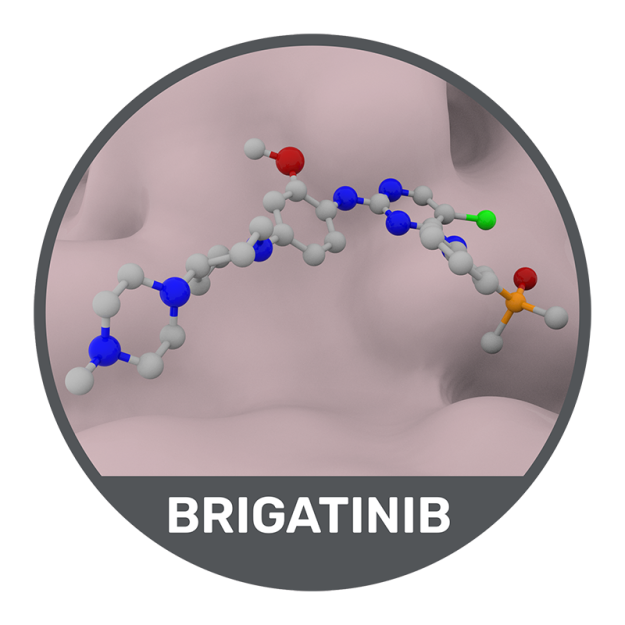
ALUNBRIG® (brigatinib) Exhibits Broad Mutational Coverage and Activity in the CNS1
ALUNBRIG inhibits tumor proliferation and growth in animal models.1
How ALUNBRIG Works as an ALK Inhibitor to Treat ALK+ mNSCLC
ALUNBRIG Mechanism of Action (MOA)

- ALUNBRIG is a tyrosine kinase inhibitor with in vitro activity at clinically achievable concentrations against multiple kinases, including ALK, ROS1, insulin-like growth factor-1 receptor (IGF-1R), and FLT-3 as well as EGFR deletion and point mutations1
- ALUNBRIG inhibited ALK autophosphorylation and the activation of downstream signaling proteins1
- Inhibited proteins: STAT3, AKT, ERK1/2, and S6 in in vitro and in vivo assays1
- ALUNBRIG was shown to inhibit cell proliferation1
- Affected the in vitro proliferation of cell lines expressing EML4-ALK and NPM-ALK fusion proteins1
- ALUNBRIG inhibited tumor growth1
- Demonstrated dose-dependent inhibition of EML4-ALK+ NSCLC xenograft growth in mice1
- At clinically achievable concentrations (<500 nM), brigatinib inhibited the in vitro viability of cells expressing EML4-ALK and 17 mutant forms associated with resistance to ALK inhibitors including crizotinib, as well as EGFR-Del (E746-A750), ROS1-L2026M, FLT3-F691L, and FLT3-D835Y1
In Vitro: ALUNBRIG Inhibited 17 ALK Inhibitor-Resistant Mutations2
ALUNBRIG exhibited in vivo antitumor activity against 4 mutant forms of EML4-ALK, including the G1202R and L1196M mutants identified in NSCLC tumors in patients who had progressed on crizotinib.1
ALUNBRIG Demonstrated In Vivo Antitumor Activity in CNS in Animal Models1
ALUNBRIG reduced tumor burden and prolonged survival in mice with an ALK-driven tumor cell line implanted intracranially.1
Preclinical activity does not necessarily correlate with clinical outcomes.
Explore systemic first-line efficacy findings for ALUNBRIG in ALK+ mNSCLC1
1L, first-line; ALK, anaplastic lymphoma kinase; ALK+ mNSCLC, anaplastic lymphoma kinase + metastatic non-small cell lung cancer; AKT, protein kinase B; APRN, Advanced Practice Registered Nurse; CNS, central nervous system; EGFR, epidermal growth factor receptor; EGFR-Del, epidermal growth factor receptor deletion; ERK1/2, extracellular signal-regulated kinase 1/2; EML4-ALK, echinoderm microtubule-associated protein-like 4 anaplastic lymphoma kinase; FLT-3, FMS‐like tyrosine kinase 3; FNP-C, IL, Family Nurse Practitioner Certified, Illinois; mNSCLC, metastatic NSCLC; MOA, mechanism of action; MSN, Master of Science in Nursing; NSCLC, non-small cell lung cancer; NPM-ALK, nucleolar protein nucleophosmin- anaplastic lymphoma kinase; ROS1, ROS proto-oncogene 1; S6, ribosomal protein S6; STAT3, signal transducer and activator of transcription 3.